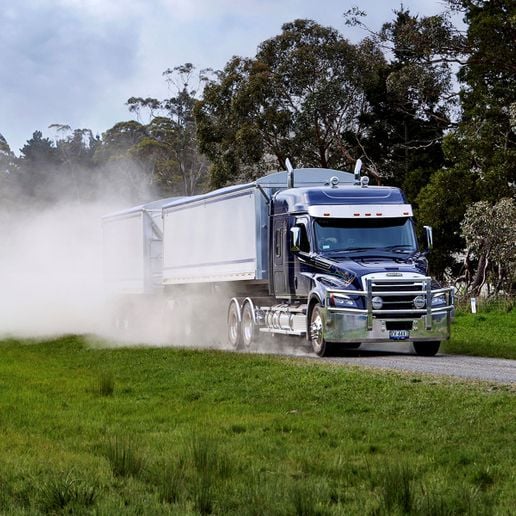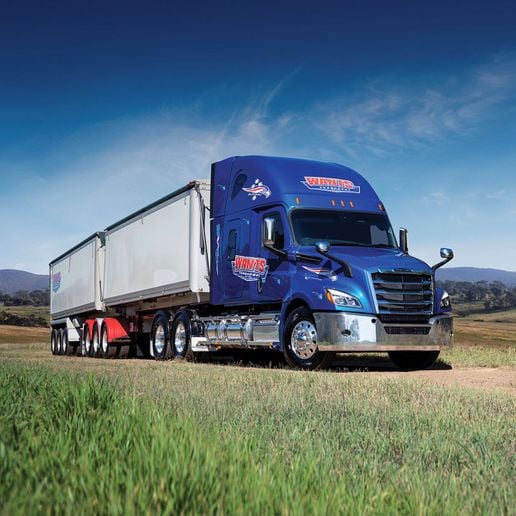Trucker Access › Forums › Diesel News › Even the Swedes are Doing Turnpike Doubles – On the Road
- This topic has 0 replies, 1 voice, and was last updated 10 months ago by
 EazyRiDer66.
EazyRiDer66.
-
AuthorPosts
-
June 5, 2024 at 1:00 pm #23995
 EazyRiDer66Keymaster
EazyRiDer66Keymaster

Volvo’s new 780-horsepower D17 diesel engine is pulling 35 meter combination trailers in Sweden today.
Photo: Volvo Trucks Australia
Having recovered sufficiently from the four-day barrage of technological innovation called ACT Expo 2024, I have to say the depth and breadth of what was on display was awe-inspiring.
But I did not see a single tandem-axle converter dolly on the exhibit hall floor, nor among the outside displays.
That boring, dull, mundane, and insignificant bit of hardware could cut trucking’s carbon footprint nearly in half practically overnight.
And not one to be seen.
I know, they don’t inspire the kind of thrill that hydrogen fuel cells do. They are a mere 1,000 pounds of steel and rubber. And not a wire in sight.
Who could possibly get excited about something like that at a time like this?
Yeah, here goes Park, again. On a tear about longer-combination vehicles, or turnpike doubles if you prefer.
I wrote an extensive analysis on these things back in 2019, illustrating the safety and fuel efficiency benefits — all based on existing studies and research done mostly outside the U.S.
On paper, the research makes a pretty compelling argument in favor of turnpike doubles. The biggest impediment to their implementation, however, seems to be human nature.
And frankly, it’s a pretty weak argument in light of the carbon reduction challenges we face going forward.
We Don’t Want LCVs
Not long after my LCV piece appeared, I had a call from Charlie Willmott, CEO of WillGo Transportation Consulting. He said he agreed with most everything I had written. But he said it was all moot because we would never see more LCVs on U.S. highways in our lifetime. I invited him to write a column explaining his rationale.

One major problem with adopting so-called “turnpike doubles” in North America is public perception of the vehicles.
Photo: Daimler Trucks Australia
I can’t argue with his reasoning, but what a bizarre spectacle it is. He mentioned opposition from railroad lobby groups and safety advocates (one and the same?), as well from certain segments within this industry. I get that. Trying to limit competition is a pretty strong motivator, as is reluctance to invest in additional equipment.
Their safety record in other countries is substantially better than traditional five-axle tractor-semi-trailers, and the environmental benefits are simply too great to ignore — but ignore them we will.
Charlie wound up his column like this:
“… regardless of the sound rationale for change in the interest of economic efficiency, reduced carbon emissions, enhanced public safety, the flag and apple pie, the freeze (ISTEA of 1991) will remain until the rules on special interest lobbying and campaign finance are re-written to promote public service and responsibility over self-interest and getting re-elected. In other words, sadly, not in my lifetime.”
Regrettably, Charlie’s probably correct.
The Swedes are on the Right Track
This issue percolated to the surface again, mostly because of Volvo’s recent announcement of a 700-hp diesel engine designed for heavy haulers. Specifically, newly allowed 34.5-meter (113 feet) long-combination units weighing up to 60 tons pulled by a single tractor in Sweden.
My colleague, Jack Roberts, has reported extensively on Volvo’s big new 780-hp, 2,802 lb-ft, D17 engine, said to have been designed exclusively to power these extra-long, extra-heavy trucks.
A few months earlier, Volvo had a bunch of North American truck journalists over to headquarters in Gothenburg to see the latest in its electric-truck line up. All fine trucks, and machines any driver would be happy to pilot, but even the best one had a range of less than 300 miles.
That’s fine as far as BEVs go, but the lineup doesn’t account for long-haul, which even in Europe accounts for a significant chunk of road transport. Sweden plans to use the longer rigs on a select number of highways where freight moves over longer distances, like 500-600 miles.
The Swedish solution is to double the load while using a single power unit, thereby getting much more work done with just a slight increase in the fuel burn compared to a pulling a single trailer.
The touted result is a 27% reduction in CO2 emissions.
Find me a single example of all the technology on the floor at ACT Expo that can match that at scale right now, in 2024.
Freight Efficiency or Political Bottleneck?
Actually, the parking lot adjacent to the Las Vegas Convention center was full of them. Literally any long-haul tractor today with a decent sized engine could pull two trailers, nearly doubling the freight efficiency, and cutting fuel consumption by at least a third compared to two trucks pulling two trailers.

Combination trailers have a well-established history of moving more freight while burning less fuel.
Photo: Daimler Trucks Australia
Canada does quite well with such combinations. Length limits there allow for two 53-foot trailers, a convertor dolly, and a sleeper cab tractor for an overall length of 40 meters (131 feet). Weight is capped at 62,500 kg (138,000 lbs) on nine axles.
Those things shine in high-cube freight applications. Two full trailer loads for little more fuel than a single load.
Alas, as Charlie Wilmott explained, it’s probably never to be.
But wait: What if we pulled those two trailers with renewable diesel, or maybe renewable natural gas?
Cummins’ new X15N would be up to the task.
Or maybe autonomous LCVs. That would get the attention of the tech mavens and the green crowd. And it would leave the safety advocates, the railroads, and other naysayers with much weaker arguments.
-
AuthorPosts
- You must be logged in to reply to this topic.